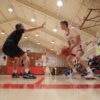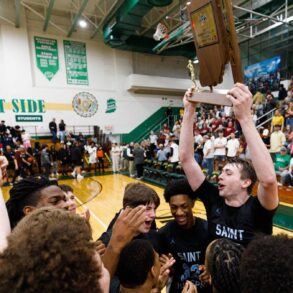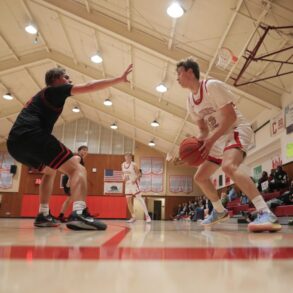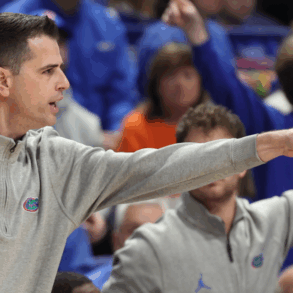Portal combat was alive and well this offseason in college basketball, with more money being thrown around than ever before in attempts to create the perfect rosters to compete for a national championship.
After the SEC collectively produced one of the best seasons in the history of the sport, many of the league’s teams have many roster spots to fill to maintain that level of success. Between the number of star players out of eligibility or players leaving early to go to the NBA Draft, the SEC will look drastically different next season.
The result is an influx of talent through the transfer portal. These players come from all over the country — from low-major, mid-major, and high-major programs, and even the junior college and Division II ranks.
Today, HawgBeat will be ranking the top five transfer classes in the conference. This is solely based on the influx of transfer talent and will not take into account players lost to the portal for each team.
It also will not factor in roster retention, which will negatively impact teams that prioritized retention, even though more retention has been a major factor for program success in the portal era. To make things more balanced, though, sheer volume of additions will not be a factor, but rather the quality of the class as a whole.
For instance, just because Texas A&M and LSU have added the most transfers in the SEC, that doesn’t guarantee either a spot in this list. Quality over quantity will be the driving factor in these rankings, but that will also become more difficult for teams with so few transfer additions like Arkansas, Florida, or Tennessee.
Without further ado, here’s how HawgBeat’s Jackson Collier ranks the top five portal classes in the SEC…
Advertisement
1) Auburn
The Auburn Tigers lost almost all of their production from last year’s team, with a majority of their starters and experienced depth pieces exhausting their eligibility. Because of this, the Tigers have added a healthy amount of transfer talent so far, highlighted by UCF transfer Keyshawn Hall.
Two other major additions came in the form of role players KeShawn Murphy (Mississippi State) and Kevin Overton (Texas Tech). While the two combined for just four starts last season, both played for NCAA Tournament teams and have winning backgrounds.
With the idea that talent and fit are at a premium in portal talent translating to team success, these three players that highlight the Tigers’ class have them with a solid core of potential starters for next season.
The other three additions for Auburn all come from outside the Division I ranks, with two coming from JUCO and one in the D-II realm. While the competition level might be cause for concern, Abdul Bashir and Elyjah Freeman were scoring machines at their respective institutions, averaging 27.2 and 19.3 points per game, respectively.
Emeka Oporum, on the other hand, might not be an elite scorer, but more of a productive role player in the frontcourt, which is exactly what the Tigers need outside of the other players discussed.
The lack of overall retention might mean that Auburn takes a step back next season, especially if freshman sensation Tahaad Pettiford stays in the NBA Draft, but on paper, the portal class was assembled with a mix of talent, role players, and winners.
Plus, I’d say Bruce Pearl has the best eye for and track record of producing talent out of the JUCO and D-II ranks, which is a big reason why I do not have a ton of concern for those portal additions here.
2) Oklahoma
Perhaps one of the surprisingly strong portal classes so far is Oklahoma. Head coach Porter Moser took a roster that was commonly projected towards the bottom of the SEC and earned an NCAA Tournament bid last year. This offseason, the Sooners flipped the script.
While the Sooners lost a ton of players due to exhausting eligibility, Oklahoma only lost one contributor of note in Duke Miles, who has committed to and decommitted from both Virginia and Texas A&M already.
To replace the lost production, Moser landed talent from the high-major ranks. Three of the four transfer additions are from high-major programs — two of those starters — and one is a role player on a winning team.
Perhaps the strongest addition to the roster was Notre Dame transfer Tae Davis, who averaged 15.1 points and 5.3 rebounds per game last season for the Fighting Irish.
The other two high-major additions are somewhat wild cards, but on paper seem to be good-to-great additions to the roster. Miami transfer Nijel Pack is a high-level scorer and has been in every collegiate season he’s played. Moser did wonders with a ball-dominant scoring threat last year in Jeremiah Fears, so he could potentially fill that type of role, but coming off an injury, there is always cause for concern about returning to playing at a high level.
Alabama transfer Derrion Reid is talented and has potential to develop, and maybe a new system with less overall talent around him will allow his skillset to be on display more. It is a worthy wager for Moser in acquiring a talented role player from a winning program.
Xzayvier Browen from St. Joseph’s also fills the high-octane, high-volume scorer mold, giving Moser and the Sooners a dangerous 1-2 punch at the guard spot.
All things considered, this group of four transfers gave Moser high major experience, multiple scorers, some shooters, and a good amount of experience and talent.
3) Tennessee
Tennessee is another team that did not lose anyone of significance to the portal, but did through exhausting eligibility. Even so, the Volunteers opted to refill their roster through the high school ranks, primarily with five-star Nate Ament highlighting a top-15 ranked class in the country.
Rick Barnes has found ample success in the transfer portal in recent years and looks to have done it again this year. The three-man class (so far) might be small, but as a whole still looks better than most of the SEC. Landing two regular starters is a huge win in the portal for any team, especially in the high-major ranks.
Barnes got his high-major starting experience from Maryland transfer Ja’Kobi Gillespie, who averaged 14.7 points and shot 40.7% from three. Another player with starting experience, Louisiana Tech transfer Amaree Abram, also adds 12.3 points per game and 37.3% from three on the year.
If anything, Barnes has proven he has an eye for shooters/scorers from the low -to-mid major ranks, after signing Dalton Knecht and Chaz Lanier in back-to-back seasons, so Abram’s impact likely could be greater at Tennessee than at other potential stops.
To round things out, Tennessee landed Vanderbilt transfer Jaylen Carey, who averaged 8.0 points and 5.7 rebounds per game in a reserve role on an NCAA Tournament team. Those are the kinds of players — high major talents from winning programs that know, accept, and buy into a role — that can truly make or break a transfer class.
Maybe I’m too high on this small collection of talent, but I think the type of talent mixed with the system and needs makes it one of the best in the SEC.
4) Kentucky
This is where the rankings get dicey.
I cannot objectively exclude Kentucky from the top five because of the amount of talent they’ve accumulated in the portal this offseason. However, the subjective portion of this ranking keeps me from putting them higher than fourth.
This is not some vendetta against Kentucky or the fanbase, but rather just how different the approach the roster building is this season compared to last. Last season, Mark Pope filled his roster with high-quality role players and shooters who bought into a system and spaced the floor at a high level. There were some deficiencies, including in the athleticism department and on the defensive end, but the Wildcats were also riddled with injuries.
This portal process seemed to be somewhat of an overcorrection. Pope added a ton of athleticism and better defensive players, but added just one high-percentage, high-volume shooter. The Wildcats added an incredibly inefficient guard in Jaland Lowe, a three-year role player at Florida, and the most heralded and most talented player in the class is coming off a torn ACL in Jayden Quaintance.
Will this class work as a whole? Of course, there’s a chance. There’s a chance each of these rankings ages incredibly poorly. To me, though, the lack of shooting and the lack of “buy-in” guys make these additions good, but not good for the system.
But because the talent acquired is still present, it has to be considered as a top transfer class in the SEC, no matter how you slice it.
5) Texas
The Texas transfer portal class isn’t sexy, but it’s practical, and practicality matters in the portal. New head coach Sean Miller faced a near-complete rebuild, but managed to retain a few key pieces from last year’s NCAA Tournament team.
With the retention and just one high school commitment, the Longhorns have been leaning on the portal to fill most areas of need, and they’ve done so adequately.
Miller brought over two transfers from Xavier with him — both starters — in Dailyn Swain and Lassina Traore. Additionally, Miller added regular starters at other successful programs like Simeon Wilcher (St. John’s) and Matas Vokietaitis (Florida Atlantic), plus a regular contributor at Purdue in Camden Heide.
These players don’t necessarily have numbers that jump off the page, but they all come from winning programs, all have extensive experience, and a couple already know Miller’s system firsthand. All that combined, I’d say it makes for a sneaky-good portal class in the SEC.
Honorable Mentions:
Arkansas
The Razorbacks only have two portal additions to this point — Malique Ewin and Nick Pringle. Both fill team needs and are talented players, but the Razorbacks are a victim of prioritizing retention over the portal for this offseason rankings. They will probably be better off next season because of it.
Florida
Similar reasoning to Arkansas here. The Gators added two solid players in Xavien Lee and AJ Brown, but again, it is hard to justify ranking them in the top five with just two additions. While this poll was quality over quantity, it is hard to make the argument for just two quality players when the teams in the list each have three-plus quality players.
Mississippi State
The Bulldogs added sufficient talent, but not quite to the level of other schools. Achor Achor is a major question mark, Amier Ali is okay but nothing special, which really leaves a core three-man class of Quincy Ballard, Ja’Borri McGhee, and Jayden Epps. I think that is a strong three-man class, but not quite to the level of any of the teams in the top five.
This post was originally published on this site be sure to check out more of their content.







